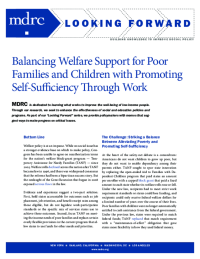Balancing Welfare Support for Poor Families and Children with Promoting Self-Sufficiency Through Work

Bottom Line
Welfare policy is at an impasse. While no social issue has a stronger evidence base on which to make policy, Congress has been unable to agree on reauthorization terms for the nation’s welfare block-grant program — Temporary Assistance for Needy Families (TANF) — since 2005. Welfare rolls declined across the nation after TANF became law in 1996, and there was widespread consensus that the reforms had been a bipartisan success story. But the onslaught of the Great Recession that began in 2008 exposed serious flaws in the law.
Evidence and experience suggest a two-part solution: First, hold states accountable for outcomes such as job placement, job retention, and benefit receipt rates among those eligible, but do not legislate work-participation standards or the specific mix of services states use to achieve those outcomes. Second, focus TANF on meeting the income needs of poor families and replace certain overly flexible provisions in the current program that allow states to use funds for other needs and priorities.
The Challenge: Striking a Balance Between Alleviating Poverty and Promoting Self-Sufficiency
At the heart of the safety-net debate is a conundrum: Americans do not want children to grow up poor, but they do not want to enable dependency among their parents either. TANF sought to spur state innovation by replacing the open-ended Aid to Families with Dependent Children program that paid states an amount per enrollee with a capped block grant that paid a fixed amount to each state whether its welfare rolls rose or fell. Under the new law, recipients had to meet strict work requirement standards or states could lose funding, and recipients could only receive federal welfare dollars for a limited number of years over the course of their lives. Poor families with children were no longer automatically entitled to cash assistance from the federal government. Under the previous law, states were required to match federal funds; TANF replaced that match requirement with a “maintenance-of-effort” obligation that gave states more flexibility in how they used federal money.
What Was the Result of Welfare Reform?
Initially, welfare caseloads fell rapidly and employment rates among single parents reached new highs. TANF’s work requirements and time limits provided a push off welfare just as the booming 1990s economy was pulling nearly every able-bodied welfare recipient into low-wage work — work that was supplemented by the recently enhanced Earned Income Tax Credit (EITC). But by the early 2000s, caseload declines leveled off and single parents’ employment rates began to decline. Poverty rates began to rise, especially the rate of deep poverty (the fraction of families with incomes below 50 percent of the federal poverty level). When the Great Recession hit, employment rates plummeted and poverty rose substantially. In contrast to previous recessions, welfare caseloads did not rise in most states, in part because states had committed TANF funds to other needs and in part because they were no longer required to assist every eligible family.
Today’s welfare program serves fewer than 30 percent of those eligible; TANF’s predecessor served close to 80 percent. In real dollars, spending on cash assistance has declined from roughly $30 billion in 1996 to roughly $8 billion today, with some states spending less than 20 percent of their TANF funds on cash assistance, work, or child care. Yet the fraction of children living in deep poverty has risen by 50 percent. Welfare dependency fell, but deep poverty rose.
Overly Prescriptive Work-Participation Requirements
To “end welfare as we know it” and to ensure a focus on work, a state was required to have 50 percent of its single-parent caseload and 90 percent of its two-parent caseload working or participating in approved activities for 30 or more hours per week. If it did not, it could incur a financial penalty.
Few states could meet these standards but initially none had to, because a state could reduce its participation standard by an amount equal to the percentage-point reduction in its caseload since 1995. In the boom economy of the 1990s, with welfare rolls falling, states were able to reduce their effective participation standards to between 0 percent and 15 percent of their caseloads, levels that they could readily reach. In an effort to make work-participation requirements real, in the 2005 reauthorization Congress established a new start date for the caseload-reduction credit, effectively eliminating it. Suddenly, states had to meet the law’s stated work-participation standards, and few could. In fact, of the many welfare-to-work programs that MDRC has evaluated over decades, none would have achieved these participation rates, not even the most effective of them. Even fewer could have met the weekly hours requirement.
Facing penalties that would reduce their block grants, states began to look for work-arounds. They moved nonworking welfare recipients to state-only programs that did not have to meet federal rules. They provided small cash payments to working individuals on food stamps, artificially increasing the fraction of TANF recipients who met work requirements. Some states sought to reduce their caseloads by closing the door of the welfare system through onerous application and renewal processes.
Overly Flexible Maintenance-of-Effort Provisions
Under the previous law, states were required to match 17 percent to 50 percent of each federal dollar spent. TANF replaced that requirement with a flexible maintenance-of-effort provision that asked states to maintain only 75 percent to 80 percent of their 1994 spending (from nonfederal funds) on TANF-related activities such as cash and emergency assistance, job training, and child care. The law defined the purposes for which those funds could be used very broadly: providing assistance to needy families, ending dependency through work and marriage, reducing out-of-wedlock pregnancy, and promoting the formation of two-parent families. In practice, nearly any expenditure can count.
When the law was reauthorized in 2005, it also allowed states to count “third-party spending” toward their maintenance-of-effort obligations. That spending could come from food banks or homeless shelters, local Boys and Girls Clubs, or even in-kind contributions. TANF became a funding source, not a program. In short, while work mandates were too prescriptive, maintenance-of-effort provisions were too lax.
An Evidence Base Upon Which to Build
Both the 1988 and 1996 welfare reforms drew on results from many large-scale welfare-to-work experiments conducted over two decades. These tests sought to inform the long-standing debate about what works best: a strategy that helps welfare recipients find work quickly or one that focuses first on helping them obtain some basic education and training. The most reliable answer to these questions can be found in the National Evaluation of Welfare-to-Work Strategies, a multiyear random assignment study involving more than 15,000 people. Initially, both the work-first and the education-first groups had higher average earnings and lower welfare receipt than those in the control group. Not surprisingly, in the first 2 years, the work-first group earned a modest amount more than the education-first group. By years 3 through 5, though, the education-first group’s earnings had essentially caught up. Some 10 to 15 years later the education-first group may have had somewhat higher earnings, although these differences were not large enough to be estimated reliably. From a government-budget perspective, work-first has the edge: while both approaches yield welfare savings, work-first does so sooner, although here too the differences are modest.
If the goal is to increase recipients’ earnings, both work-first and education-first approaches are effective, suggesting that states should be held accountable for the ends — an increase in employment and earnings — not the means. But both approaches also fall short. Neither resulted in systematically greater income or reduced poverty, and thus neither generally improved families’ economic well-being. This result suggests a need to implement and test new initiatives that might increase low-income individuals’ earnings and improve their families’ well-being.
Balancing Welfare Policy’s Dual Goals: Lessons to Guide Reauthorization
Congress intended for TANF to promote welfare-to-work programs, but the law unintentionally undermined those programs by dictating design specifications to states and establishing unreachable participation standards. Reauthorization presents an opportunity to correct these shortcomings, to promote successful welfare-to-work programs that both protect the poor and reduce dependency by encouraging and supporting work. There is strong research confirming that work-participation requirements effectively reduce welfare dependency. Moreover, the evidence indicates that states can be given substantial latitude in choosing which strategies to employ: work-first, education-first, or a combination of the two. Recent research suggests that subsidized jobs can provide short-term income support to individuals with serious barriers to employment. But none of these strategies increases income or reduces poverty. New approaches should be tried that might lead former welfare recipients to better jobs where they can take advantage of policies like the EITC that make work pay.
The design of the block grant has also had the effect of undermining the safety net. Block grants have not been adjusted for inflation or population growth, and while initially states’ falling caseloads left them with extra money, today they have 30 percent less in federal funds than they did two decades ago. The fraction of eligible, nonworking, poor families receiving income support is the lowest it has been in 50 years. These problems could be addressed by returning to a straightforward state match requirement, by refocusing TANF’s purpose (and states’ energies and resources) on the income and employment needs of nonworking poor families, and by ending expenditures on activities unrelated to cash welfare and self-sufficiency.
For more information, e-mail Gordon Berlin at gordon.berlin@mdrc.org.







